Contents
Understanding the Different Stages of Tooth Abscess and How Dental Infections Progress
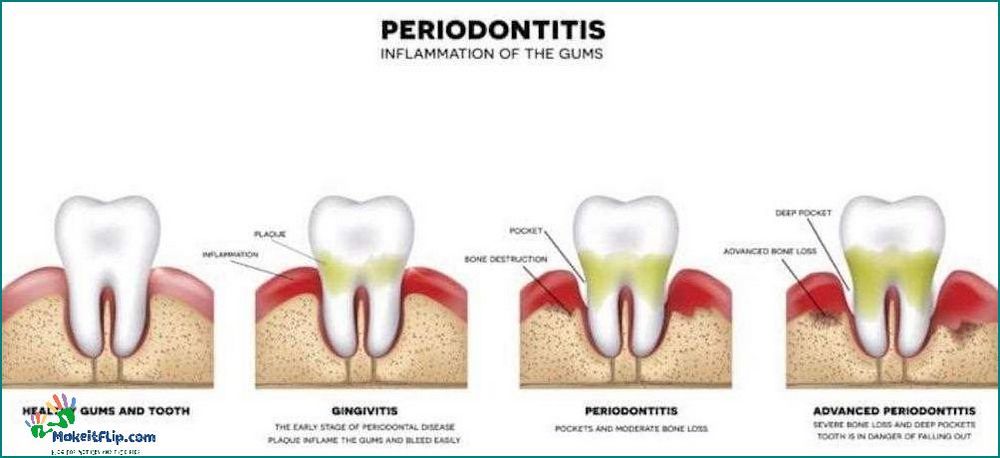
A tooth abscess is a serious dental infection that can cause severe pain and discomfort. It occurs when bacteria enter the tooth through a cavity or crack, leading to an infection in the root or surrounding tissues. If left untreated, a tooth abscess can progress through several stages, each with its own symptoms and complications.
The first stage of a tooth abscess is characterized by localized infection and swelling. The affected tooth may become sensitive to touch and temperature, and there may be a small bump or pimple-like sore on the gum near the infected tooth. As the infection progresses, the swelling may spread to the surrounding tissues, causing redness and tenderness.
In the second stage, the infection spreads deeper into the tooth and surrounding structures. The pain becomes more intense and persistent, often radiating to the jaw and ear. The affected tooth may become loose and there may be a foul taste or odor in the mouth. In some cases, the infection can cause fever and swollen lymph nodes.
If the infection is not treated at this stage, it can progress to the third stage, which is characterized by the formation of an abscess. An abscess is a pocket of pus that forms at the root of the tooth or in the surrounding tissues. This can cause severe pain and swelling, and may lead to the formation of a draining fistula, a small channel through which pus can escape.
Antibiotics are often prescribed to treat tooth abscesses, but they may only provide temporary relief. The most effective treatment for a tooth abscess is to remove the source of infection, which may involve root canal therapy or extraction of the affected tooth. It is important to seek prompt dental care if you suspect you have a tooth abscess, as early intervention can prevent the infection from progressing to more advanced stages.
Stage 1: Initial Symptoms and Early Detection
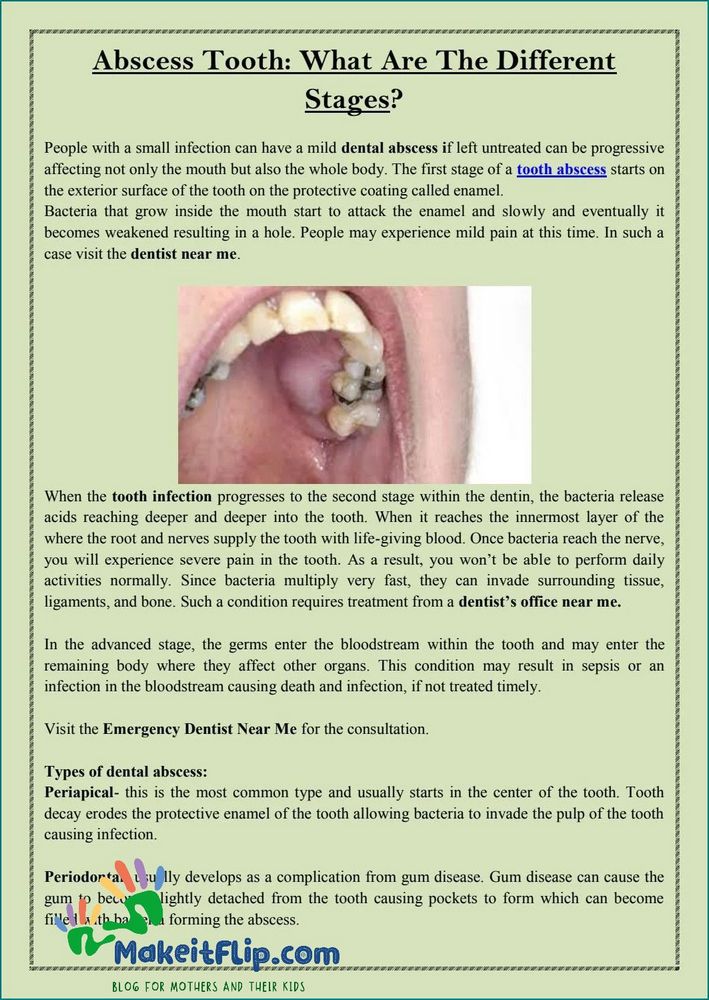
When a tooth abscess begins to develop, it often starts with subtle signs that may go unnoticed. However, early detection is crucial in preventing the infection from progressing further. Here are some initial symptoms to watch out for:
- Swelling around the affected tooth or in the surrounding gums
- Pain or sensitivity when biting or chewing
- A persistent, throbbing toothache
- Redness or inflammation in the gums
- A foul taste or odor in the mouth
If you experience any of these symptoms, it is important to seek dental treatment as soon as possible. Your dentist will examine the affected tooth and may take an X-ray to determine the extent of the infection. Early detection allows for prompt treatment, which can help prevent the infection from spreading to other areas of the mouth.
In most cases, the first stage of a tooth abscess can be treated with antibiotics to eliminate the infection. Your dentist may also recommend draining the abscess to relieve pain and pressure. It is important to follow your dentist’s instructions and complete the full course of antibiotics to ensure that the infection is fully eradicated.
Regular dental check-ups and good oral hygiene practices, such as brushing and flossing daily, can help detect and prevent tooth abscesses in their early stages. If you notice any symptoms or changes in your oral health, don’t hesitate to schedule an appointment with your dentist.
Recognizing the Signs of a Tooth Abscess
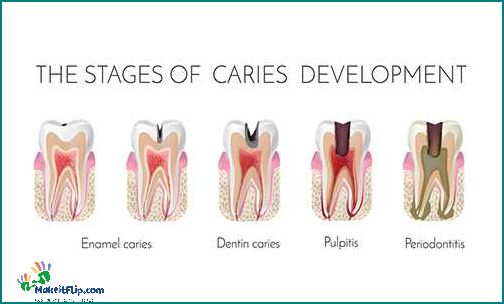
A tooth abscess is a painful dental condition that occurs when there is an infection in the tooth. It can be caused by tooth decay, gum disease, or a dental injury. Recognizing the signs of a tooth abscess is important for early detection and prompt treatment.
One of the most common signs of a tooth abscess is severe tooth pain. The pain may be constant or intermittent and can radiate to the jaw, ear, or neck. It is often described as a throbbing or sharp pain that worsens when biting or chewing.
In addition to tooth pain, other symptoms of a tooth abscess may include swelling of the face or cheek, redness and tenderness of the gums, and a persistent bad taste or odor in the mouth. Some people may also experience difficulty opening their mouth or swallowing, as well as fever and general malaise.
If you suspect you have a tooth abscess, it is important to seek dental treatment as soon as possible. The dentist will examine your tooth and may take X-rays to confirm the presence of an abscess. Treatment options for a tooth abscess may include draining the abscess, root canal therapy, or tooth extraction.
In conclusion, recognizing the signs of a tooth abscess, such as severe tooth pain, swelling, and infection symptoms, is crucial for early intervention and effective treatment. If you experience any of these symptoms, it is important to consult a dentist promptly to prevent further complications.
The Importance of Early Diagnosis
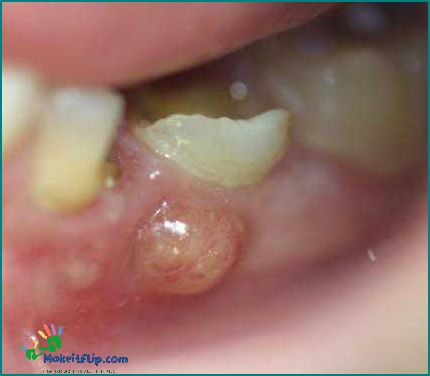
Early diagnosis of a tooth abscess is crucial in preventing the infection from progressing to more severe stages. Recognizing the signs and symptoms of a tooth abscess can help individuals seek prompt dental treatment and avoid potential complications.
One of the primary indicators of a tooth abscess is persistent pain. This pain may be sharp or throbbing and can radiate to the jaw, ear, or neck. If left untreated, the pain can intensify and become unbearable.
Another common symptom of a tooth abscess is swelling. As the infection progresses, the surrounding tissues may become inflamed, leading to noticeable swelling in the affected area. This swelling can cause discomfort and difficulty in performing daily activities such as eating or speaking.
In some cases, a tooth abscess may cause fever. The body’s immune response to the infection can result in an elevated body temperature. A persistent fever is a sign that the infection has spread and requires immediate attention.
Early diagnosis also allows for the appropriate use of antibiotics. Antibiotics can help control the infection and prevent it from spreading further. However, it is important to note that antibiotics alone cannot fully eliminate a tooth abscess. Dental treatment, such as a root canal or tooth extraction, is often necessary to remove the source of the infection.
In conclusion, early diagnosis of a tooth abscess is essential in managing the infection effectively. Recognizing the stages and symptoms of a tooth abscess, such as pain, swelling, and fever, can prompt individuals to seek timely dental care. By seeking treatment early on, individuals can prevent the infection from progressing and avoid potential complications.
Stage 2: Development and Progression
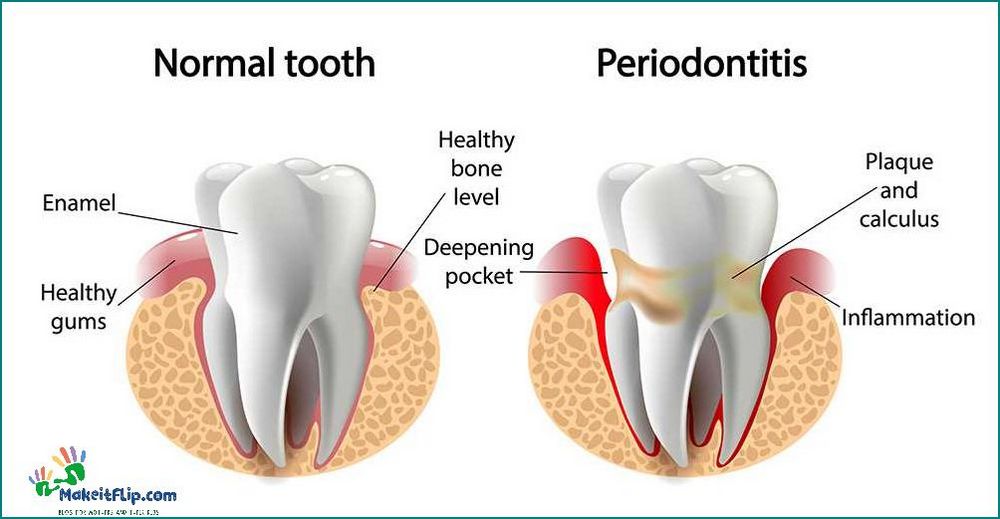
After the initial infection in stage 1, the tooth abscess enters stage 2, which is characterized by the development and progression of the infection. At this stage, the bacteria continue to multiply and spread, causing further damage to the tooth and surrounding tissues.
The infection may start to cause noticeable symptoms such as pain, swelling, and sensitivity to hot or cold temperatures. The affected tooth may become tender to touch, and the pain can radiate to the jaw or ear.
If left untreated, the infection can spread to the surrounding tissues, including the gums, jawbone, and even the face and neck. This can lead to more severe symptoms such as difficulty swallowing, a fever, and a swollen lymph node.
To prevent the infection from progressing and causing further complications, it is important to seek treatment at this stage. The dentist may prescribe antibiotics to help fight the infection and reduce inflammation. In some cases, a root canal or tooth extraction may be necessary to remove the source of the infection.
It is crucial to address the infection promptly to prevent it from spreading and causing more serious health problems. If you experience any symptoms of a tooth abscess, such as persistent pain or swelling, it is important to schedule an appointment with your dentist as soon as possible.
FAQ about topic Tooth Abscess Stages Understanding the Progression of Dental Infections
What are the stages of a tooth abscess?
The stages of a tooth abscess include initial infection, abscess formation, and abscess rupture.
What are the symptoms of a tooth abscess?
The symptoms of a tooth abscess can include severe toothache, sensitivity to hot and cold, swollen gums, facial swelling, and a bad taste in the mouth.
How is a tooth abscess diagnosed?
A tooth abscess is typically diagnosed through a physical examination, dental X-rays, and possibly a dental CT scan.
What are the complications of a tooth abscess?
Complications of a tooth abscess can include the spread of infection to other parts of the body, such as the jawbone or sinuses, and the formation of a dental fistula.
What is the treatment for a tooth abscess?
Treatment for a tooth abscess may involve draining the abscess, root canal therapy, or tooth extraction, depending on the severity of the infection.
What are the stages of tooth abscess?
The stages of tooth abscess include initial infection, abscess formation, and spread of infection.
I’m Diana Ricciardi, the author behind Makeitflip.com. My blog is a dedicated space for mothers and their kids, where I share valuable insights, tips, and information to make parenting a bit easier and more enjoyable.
From finding the best booster seat high chair for your child, understanding the connection between sciatica and hip pain, to exploring the benefits of pooping in relieving acid reflux, I cover a range of topics that are essential for every parent.
My goal is to provide you with practical advice and solutions that you can easily incorporate into your daily life, ensuring that you and your child have the best possible experience during these precious years.
